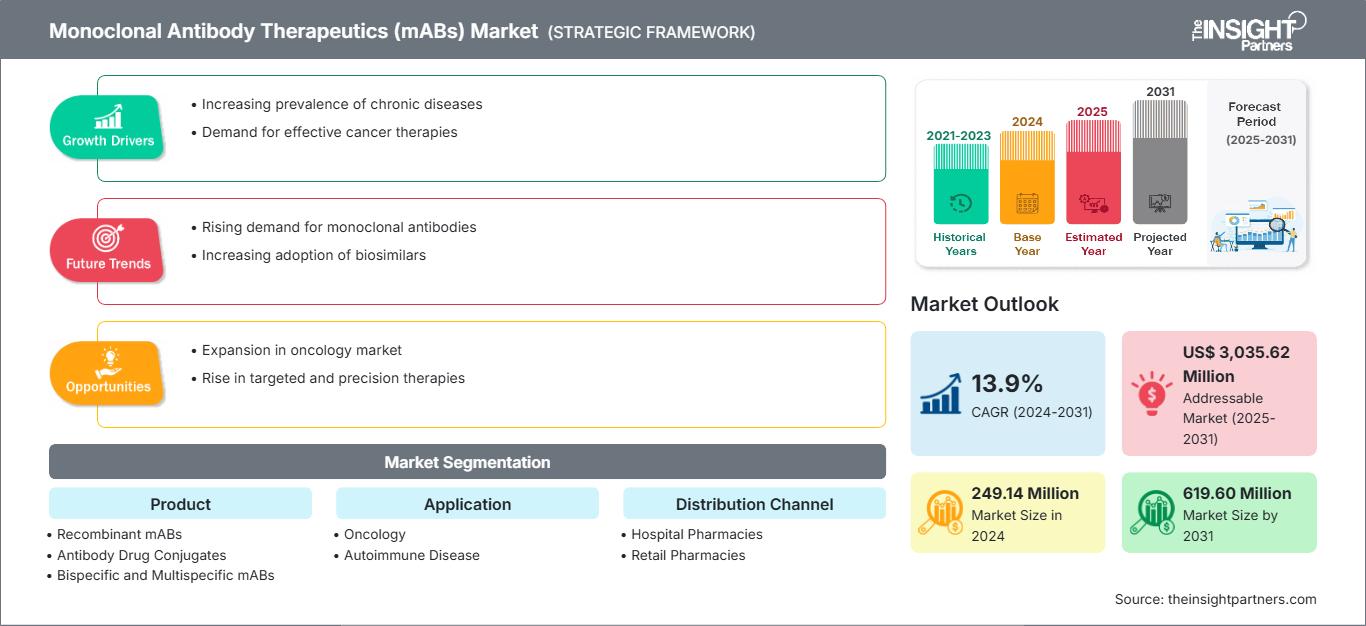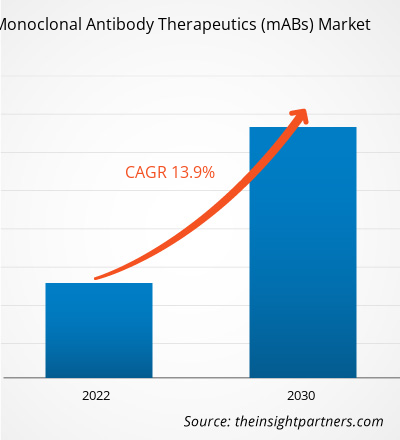单克隆抗体疗法 (mAB) 市场规模预计将从 2024 年的 2.4914 亿美元增长到 2031 年的 6.196 亿美元;预计该市场在 2025 年至 2031 年期间的复合年增长率将达到 13.9%。
市场洞察和分析师观点:
强劲的研究和开发以及慢性病患病率的上升可能会对未来几年的单克隆抗体疗法 (mAB) 市场预测产生重大影响
单克隆抗体 (mAb) 药物是对选定靶抗原具有特异性的同质抗体集合。治疗性单克隆抗体的生产过程需要哺乳动物表达系统,该系统提供糖基化、折叠、定向和共价结合抗体肽链所必需的细胞机制,从而产生完整且具有生物功能的分子。双特异性抗体和三特异性抗体等新型抗体可以识别单个抗原上的多个表位,而单域抗体可以更容易地穿透组织。这些先进的抗体类型可以提高抗体疗法的疗效,从而扩大其应用领域。这些抗体还可以形成抗体-药物偶联物,以提高化疗药物靶向特定细胞类型的效率。基于单克隆抗体的药物生产用于治疗多种疾病,推动了市场的发展。制造商通过战略发展推出的创新产品,为市场带来了丰厚的利润。此外,含有单克隆抗体(mAB)的复方药物是单克隆抗体治疗市场的一个趋势。
市场驱动力
基于mAB的多种疾病治疗药物的生产推动了市场增长
单克隆抗体疗法(mAB)被用于治疗多种疾病,包括癌症、自身免疫性疾病和代谢性疾病。由生物制药公司和科研机构生产的此类药物因其高特异性、强靶向性以及低毒副作用,在全球市场上获得了广泛关注。因此,预计 mAB 疗法生产能力的提高将推动单克隆抗体疗法 (mAB) 市场的增长。
欧盟 (EU) 和美国批准的治疗性 mAB
产品 |
品牌名称 |
疾病适应症 |
批准年份:欧盟 |
批准年份:美国 |
|
Pozelimab |
VEOPOZ |
CHAPLE疾病 |
NA |
2023 |
|
Elranatamab |
Elrexfio |
多种骨髓瘤 |
2023 |
2023 |
|
Rozanolixizumab |
RYSTIGGO |
全身性肌无力重症 |
2024 |
2023 |
|
他克他单抗 |
TALVEY |
多次 骨髓瘤 |
2023 |
2023 |
|
Epcoritamab |
EPKINLY |
弥漫大B细胞淋巴瘤 |
2023 |
2023 |
|
Mirikizumab |
Omvoh |
溃疡性结肠炎 |
2023 |
2023 |
来源:抗体协会
市场机遇
制造商通过战略发展推出创新产品
治疗性单克隆抗体 (mAB) 制造商推出产品等有机发展可能会在未来几年提振单克隆抗体疗法 (mAB) 市场。2022 年 3 月,Adagio Therapeutics, Inc. 宣布推出 ADG20 (ADINTREVIMAB)。这款新推出的产品是首个通过申请美国紧急使用授权 (EUA),在 COVID-19 暴露前和暴露后预防和治疗中达到具有统计学意义的主要终点的单克隆抗体。
此外,并购等无机发展将导致新的治疗性单克隆抗体的推出。例如,2023 年 7 月,礼来公司宣布收购 Versanis,这是一家致力于治疗心脏代谢疾病的私营临床阶段生物制药公司。礼来收购 Versanis 是为了获得其核心产品组合,包括一款名为 bimagrumab 的单克隆抗体产品。该产品目前正在“BELIEVE 2b 期临床试验”中作为独立分子进行评估。此外,该产品还正在与司美格鲁肽联合使用,以期探索其在减少脂肪量、保持肌肉量以及改善肥胖及肥胖相关并发症患者预后的潜力。上述因素将在未来几年推动单克隆抗体疗法 (mAB) 市场的增长。
单克隆抗体疗法 (mAB) 市场趋势
含单克隆抗体 (mAB) 的联合用药
根据美国国立卫生研究院 (NIH) 2021 年的报告,罗氏和再生元(两家制药公司)启动了 2/3 期临床试验,以评估联合单克隆抗体对轻度至中度 COVID-19 患者的效果。他们正在研究“REGN-COV2”,这是一种由两种单克隆抗体——卡西利维马 (casirivimab) 和伊德维马 (imdevimab)——组合而成的鸡尾酒疗法,用于治疗 COVID-19。这些公司预计,这种单克隆抗体(mAB)药物的组合疗法将使住院率降低70%,并且对12岁以上(体重超过40公斤)的儿童更有效。研究人员正在积极寻找更多此类单克隆抗体治疗组合。例如,礼来公司开发的巴姆拉尼单抗(bamlanivimab)和依替西单抗(etesivimab)已在2022年针对新冠肺炎(COVID-19)的临床研究中显示出积极的疗效。因此,用于治疗多种疾病的单克隆抗体组合疗法将在未来几年获得广泛关注,并成为单克隆抗体疗法(mAB)市场的一个显著趋势。
自定义此报告以满足您的要求
您将免费获得任何报告的定制,包括本报告的部分内容,或国家级分析、Excel 数据包,以及为初创企业和大学提供超值优惠和折扣
单克隆抗体治疗(mAB)市场: 战略洞察

-
获取本报告的主要市场趋势。这个免费样本将包括数据分析,从市场趋势到估计和预测。
报告细分和范围:
单克隆抗体疗法 (mAB) 市场分析考虑了以下细分领域:产品、应用和分销渠道
根据产品,市场分为重组 mAB、抗体-药物偶联物、双特异性和多特异性 mAB、生物仿制药等。根据应用,单克隆抗体疗法 (mAB) 市场细分为肿瘤学、自身免疫性疾病和其他。自身免疫性疾病市场进一步细分为类风湿性关节炎、牛皮癣、溃疡性结肠炎和其他。根据分销渠道,单克隆抗体治疗剂 (mAB) 市场可细分为医院药房、零售药房和其他。
就产品而言,重组 mAB 细分市场在 2022 年占据了单克隆抗体治疗剂 (mAB) 最大的市场份额。预计抗体与药物偶联物细分市场在预测期内的复合年增长率将达到 18.5%,为最快。根据 ACS Publications 的报告,治疗性重组单克隆抗体体现了最先进的生物医学研究成果,该研究通过制定有效策略来治疗多种尚无有效治疗方法的疾病。托珠单抗就是一种重组 mAB 药物,用于治疗关节炎、特发性关节炎和类风湿性关节炎 (RA)。此外,重组 mAB 还可用于治疗自身免疫性疾病和癌症等疾病。贝伐单抗是一种重组单克隆抗体(mAB),目前用于治疗乳腺癌、肺癌和结直肠癌;HIV-1;细菌毒素感染/反应,以及SARS-CoV-2和埃博拉病毒感染。
抗体-药物偶联物(ADC)是一类快速崛起的治疗药物,也是一类新兴的强效药物,利用化疗和免疫疗法相结合。根据美国国立卫生研究院 (NIH) 的一份报告,目前 ADC 主要基于免疫球蛋白G (IgG),迄今为止,已有 13 种 ADC 获得美国食品药品监督管理局 (FDA) 的批准。此外,超过 90 种 ADC 正在临床开发/试验中。
Sr. |
产品(已批准的ADC) |
疾病适应症 |
|
1 |
Mylotarg |
复发性急性髓性白血病 |
|
2 |
Adcetris |
复发性霍奇金淋巴瘤和复发性系统性间变性大细胞淋巴瘤 |
|
3 |
Kadcyla |
HER2阳性转移性乳腺癌 |
|
4 |
Besponsa |
复发或难治性CD22阳性B细胞前体急性淋巴细胞白血病 |
|
5 |
Lumoxiti |
复发或难治性毛细胞白血病或HCL |
|
6 |
Polivy |
复发或难治性(R/R)弥漫大B细胞淋巴瘤或DLBCL |
|
7 |
Padcev |
转移性尿路上皮 癌症 |
|
8 |
Enhertu |
转移性 HER2 阳性乳腺癌 |
|
9 |
Trodelvy |
转移性三阴性乳腺癌 |
|
10 |
Blenrep |
复发或难治性多发性骨髓瘤 |
|
11 |
Zynlota |
大 B 细胞 |
|
12 |
Tivdak |
复发性或转移性宫颈癌治疗 |
|
13 |
Elahere |
铂耐药性卵巢癌 |
来源:一次性使用支持文章
因此,在预测期内,ADC 的监管批准和正在进行的罕见疾病治疗方法临床试验将推动单克隆抗体治疗 (mAB) 市场在抗体与药物偶联物领域的增长。
区域分析:
根据地域分布,单克隆抗体治疗 (mAB) 市场报告涵盖北美、欧洲、亚洲太平洋、中东和非洲以及南美和中美洲。2022 年,北美占据全球单克隆抗体治疗药物 (mAB) 市场的最大份额。预计亚太地区在 2022 年至 2030 年期间的复合年增长率最高。在北美,美国占据最大的市场份额。mAB 治疗药物产品审批程序的加快使该国市场受益。根据发表在 BioMed Central 杂志上的一项研究显示的统计数据,截至 2019 年 12 月,美国 FDA 已批准 79 种治疗性 mAB。在 79 种治疗性 mAB 中,有 30 种用于癌症治疗。2021 年 5 月,FDA 宣布授权 EUA 使用一种新的治疗性 mAB——Sotrovimab——用于门诊治疗患有严重 COVID-19 的患者。 2022年2月,FDA宣布为礼来公司生产的贝布替洛维单抗(bebtelovimab)颁发紧急使用授权(EUA),该药物是针对Omicron变异株的单克隆抗体(mAB)的一个例子。此外,etesevimab也是美国FDA批准的治疗性单克隆抗体(mAB)的一个例子。
单克隆抗体治疗(mAB)市场区域洞察
The Insight Partners 的分析师已详尽阐述了预测期内影响单克隆抗体治疗 (mAB) 市场的区域趋势和因素。本节还讨论了北美、欧洲、亚太地区、中东和非洲以及南美和中美洲的单克隆抗体治疗 (mAB) 市场细分和地域分布。
单克隆抗体治疗(mAB)市场报告范围
| 报告属性 | 细节 |
|---|---|
| 市场规模 2024 | 249.14 Million |
| 市场规模 2031 | 619.60 Million |
| 全球复合年增长率 (2024 - 2031) | 13.9% |
| 历史数据 | 2021-2023 |
| 预测期 | 2025-2031 |
| 涵盖的领域 |
By 产品
|
| 覆盖地区和国家 |
北美
|
| 市场领导者和主要公司简介 |
|
单克隆抗体治疗 (mAB) 市场参与者密度:了解其对业务动态的影响
单克隆抗体治疗 (mAB) 市场正在快速增长,这得益于终端用户需求的不断增长,而这些需求的驱动因素包括消费者偏好的演变、技术进步以及对产品优势的认知度的提升。随着需求的增长,企业正在扩展产品线,不断创新以满足消费者需求,并抓住新兴趋势,从而进一步推动市场增长。

- 获取 单克隆抗体治疗(mAB)市场 主要参与者概述
以下列出了单克隆抗体疗法 (mAB) 市场领先企业的各种战略发展:
- 2023 年 1 月,阿斯利康的 Evusheld 在欧盟 (EU) 获得批准。Evusheld 是两种长效抗体的组合——tixagevimab (AZD8895) 和 cilgavimab (AZD1061)。美国政府通过卫生与公众服务部、战略防范与应对管理局和生物医学高级研究与发展局的联邦资金为该产品的开发提供了支持。
- 2023 年 8 月,再生元制药公司与生物医学高级研究与发展局 (BARDA) 达成协议,支持针对 COVID-19 的下一代单克隆抗体疗法的临床开发、临床制造和监管许可流程。根据该协议,再生元计划与美国生物医学高级研究与发展管理局 (BARDA) 合作,评估、进一步开发和生产该疗法,并开展监管活动。
竞争格局和主要公司:
葛兰素史克、罗氏制药、拜耳股份公司、安进、诺华、艾伯维、百时美施贵宝、杨森制药、默克集团和阿斯利康是单克隆抗体疗法 (mAB) 市场的领军企业。单克隆抗体疗法 (mAB) 市场报告涵盖了公司定位和集中度,以评估市场主要参与者的表现。
- 历史分析(2 年)、基准年、预测(7 年)及复合年增长率
- PEST和SWOT分析
- 市场规模、价值/数量 - 全球、区域、国家
- 行业和竞争格局
- Excel 数据集
近期报告
客户评价
购买理由
- 明智的决策
- 了解市场动态
- 竞争分析
- 客户洞察
- 市场预测
- 风险规避
- 战略规划
- 投资论证
- 识别新兴市场
- 优化营销策略
- 提升运营效率
- 顺应监管趋势






















 获取免费样品 - 单克隆抗体治疗(mAB)市场
获取免费样品 - 单克隆抗体治疗(mAB)市场